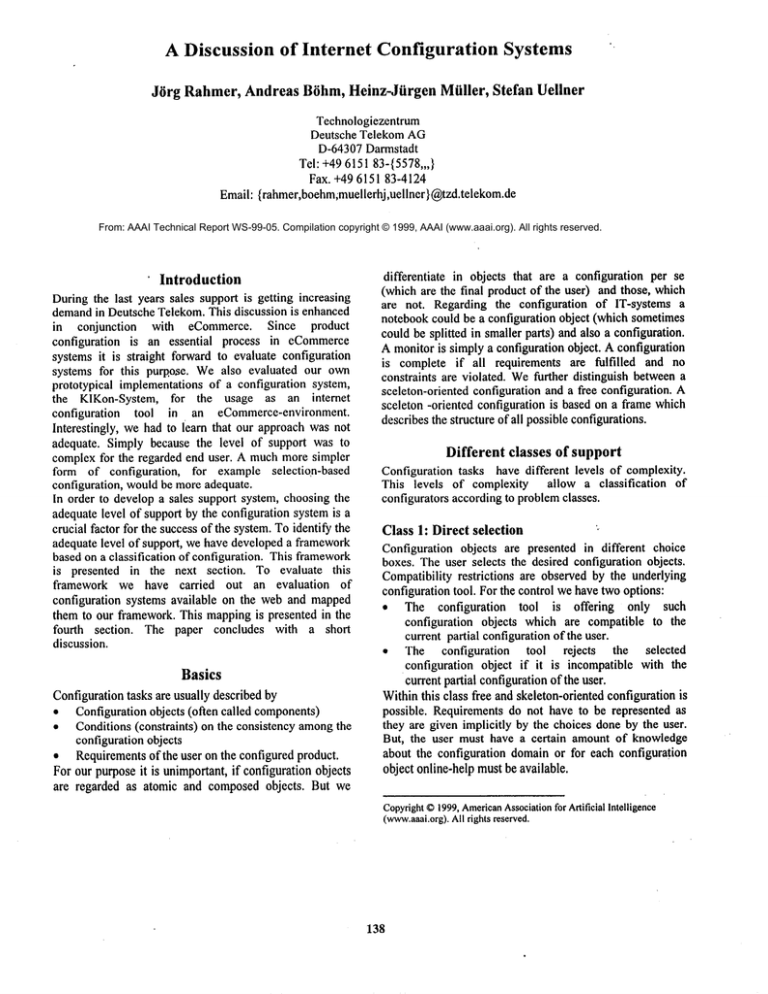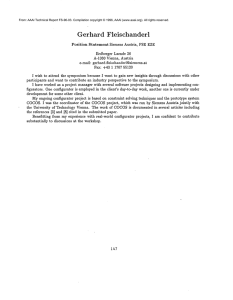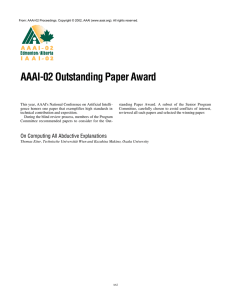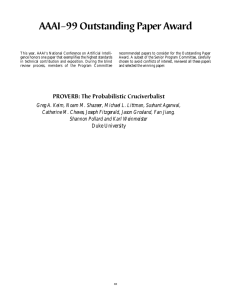
A Discussion
of Internet
Configuration
Systems
JOrgRahmer,AndrcasBOhm,
Heinz-JiirgenMiiller, Stefan Ueliner
Technologiezentrum
Deutsche Telekom AG
D-64307 Darmstadt
Tel: +49 6151 83-{5578,,,}
Fax. +49 6151 83-4124
Email: { rahmer,boehm;muellerhj,uellner} @tzd.telekom.de
From: AAAI Technical Report WS-99-05. Compilation copyright © 1999, AAAI (www.aaai.org). All rights reserved.
Introduction
During the last years sales support is getting increasing
demandin Deutsche Telekom. This discussion is enhanced
in conjunction
with eCommerce. Since product
configuration is an essential process in eCommerce
systems it is straight forward to evaluate configuration
systems for this pu~ose. Wealso evaluated our own
prototypical implementations of a configuration system,
the KIKon-System, for the usage as an internet
configuration
tool in an eCommerce-environment.
Interestingly, we had to learn that our approach was not
adequate. Simply because the level of support was to
complex for the regarded end user. A muchmore simpler
form of configuration, for example selection-based
configuration, wouldbe more adequate.
In order to develop a sales support system, choosing the
adequate level of support by the configuration system is a
crucial factor for the success of the system. To identify the
adequate level of support, we have developed a framework
based on a classification of configuration. This framework
is presented in the next section. To evaluate this
framework we have carried out an evaluation
of
configuration systems available on the web and mapped
them to our framework. This mappingis presented in the
fourth section. The paper concludes with a short
discussion.
Basics
Configuration tasks are usually described by
¯ Configuration objects (often called components)
¯ Conditions (constraints) on the consistency amongthe
configuration objects
¯
Requirementsof the user on the configured product.
For our purpose it is unimportant, if configuration objects
are regarded as atomic and composed objects. But we
differentiate in objects that are a configuration per se
(which are the final product of the user) and those, which
are not. Regarding the configuration of IT-systems a
notebook could be a configuration object (which sometimes
could be splitted in smaller parts) and also a configuration.
A monitor is simply a configuration object. A configuration
is complete if all requirements are fulfilled and no
constraints are violated. Wefurther distinguish between a
sceleton-oriented configuration and a free configuration. A
sceleton -oriented configuration is based on a frame which
describes the structure of all possible configurations.
Differentclasses of support
Configuration tasks have different levels of complexity.
This levels of complexity allow a classification
of
configurators according to problemclasses.
Class 1: Direct selection
’
Configuration objects are presented in different choice
boxes. The user selects the desired configuration objects.
Compatibility restrictions are observed by the underlying
configuration tool. For the control we have two options:
¯ The configuration
tool is offering only such
configuration objects which are compatible to the
current partial configurationof the user.
¯
The configuration
tool rejects
the selected
configuration object if it is incompatible with the
current partial configurationof the user.
Withinthis class free and skeleton-oriented configuration is
possible. Requirements do not have to be represented as
they are given implicitly by the choices done by the user.
But, the user must have a certain amount of knowledge
about the configuration domain or for each configuration
object online-help must be available.
Copyright
©1999,American
Association
for Artificial Intelligence
(www.aaai.org).
Allrightsreserved.
138
Class 2: Multicriterial search
In this class a user selects the properties of the desired
configuration objects, which are given by choice boxes.
The user interface assists mainly the selection of
predefined properties. With each choice of the user, the
configurator restricts the possible set of configurations
until one resulting configuration remains. If the chosen
requirements are to restrictive,
then the process ends
without a result. In this case, often a step-wise resetting of
chosenrequirements is possible (backtracking).
Class 3: Soft search and adaptation
If configuration objects can be clustered and if there is
additional
information
about the similarity
of
configuration objects and their clustering available, a kind
of soft search can be realized. In addition to exact
matching results also configurations can be presented to
the user which only partially match her requirements. To
sum up, this class is defined as an extension of the
description of configuration objects plus the addition of
soft constraints.
Class 4: From-scratch configuration based on a
complete and consistent problem specification
If the adaptation of an existing solution is not satisfying, a
from-scratch configuration is becoming necessary. In
principle, the from-scratch configuration can either be
done interactively,
semi-automatically
or fully
automatically. Beside of knowledgefor the requirement
specification, a domainmodelis necessary, which can be
expressed in a constraint-, rule-, skeleton-, port- or
resource-based approach. Whichknowledgerepresentation
technique is to choose, dependson the application domain.
Class 5: From-scratch configuration
based on
incomplete and inconsistent problem specification
In somedomains,in relation to problemclass 4, one has to
expect incomplete specifications,
which result in an
increased number of alternative solutions and problem
specifications. Hence, beside of generating solutions for
the user, the user has to be assisted in specifying her
requirements. Especially, the comparison of, the
navigation through and the integration of alternative
configurations has to be supported by the system. This last
form is comparable to explorative design and therefore
knownas explorative configuration. Case-based reasoning
methods can also be used to complete the requirement
specifications.
Evaluation of configurators in the WWW
Table 1 showsa list ofconfigurators found in the web. The
goal of this study was to get a rough overview of the
methodsand players in the web configurator market. For
the evaluation, we have looked at different criterias, like
the product domain (what is getting configured) , the
methodsused, the result and its presentation, is onlineordering possible and finally the ergonomics of the user
interface. Furthermorewe classified the configuration tools
according to the abovediscussed classification scheme.
Discussion
The analysis leads to the followingresults:
Most of the described configurators fall in class 1.
Typically, a choice of configuration objects is offered
to the web customer. By selecting from this choices the
web customer designs her configuration. A highlight in
this category is the configurator of Pacific MicroData
which allows to state more general requirements about
the desired product. The configuration systems uses
this input to producea prototypical suggestion whichis
then refined by the user selecting configuration objects.
Another highlight is the configuration system of IBM
Canada. Step by step possible componentsare selected.
After each selection a consistency check is done and
newobjects are introduced automatically, if there is no
choice available. Suchkind of inferences are normally
not available or not transparent to the user.
¯ Wealso identified some systems up in the classes two
and three. But none of the systems, can be compared
with a full configuration system. In our opinion there
are two reasons: Acquiring the domainknowledgefor a
configuration system is really a very demandingtask
that can not be done by sales people. So often this task
has to be done by the designers of the configuration
systems. But those wont like to maintain the
knowledge base over a couple of years. The second
reason is the web customer who has to use the
configuration system. She should be able to understand
the handling and the way the web-configurators within
a couple of seconds. But configuration systems from
class 4 and 5 often require an experienced user whois
definitely not the standard webcustomer.
¯ All configurators are used for the configuration of
goods. Therefore they could easily be integrated in the
workflowof a merchandise planing and control system.
Regarding the special eCommerce-situation, we find
quite often online-ordering possibilities integrated with
the configuration system.
Conclusions
According to our experience and the trends that can be
regarded on the WWW,
we believe that there are two
demandingtasks for configuration system designers:
¯ Howcan the user-interfaces of a configuration systems
of class 4 or 5 used by a webcustomer?
Copyright © 1999, AmericanAssociation for Artificial Intelligence
(www.aaai.org).All rights reserved.
139
simplified in order to be done by a normal web editorial
department for an online-shop?
ttow can the costs for knowledge acquisition
and
maintenance of a configuration
domain model be
.lowered? Or alternatively,
how can this job be
Nr. Company
1
Aberdeen LLC
2
Compunity
3
Dell ComputerCorp.
4
5
6
7
8
9
10
11
12
13
14
15
16
Gateway2000 Inc.
HewelI-Packard Company
IBMCanada Ltd.
IBMUnited States
Pacific MicroData Inc.
PNYTechnologies Inc.
SenecaData Distributor Inc.
State Street Direct Online
Sun Data
TNPG- The NewPower
Generation
Ti~er Direct
ttec ComputerB.V.
Vobis Microcomputer AG
Deutschland
17 Arcor Mannesmann
Telecommunication
18 AT&T
19 British Telecom
phones_finder
20 British Telecomcall_pricer
21 Cisco S),stems Inc.
22 Adam Opel AG
23
24
25
26
27
28
29
30
31
32
33
34
35
36
37
Class
Homepage
http://www.aberdeeninc.com/abcatg/SCMAIN.HTM
http://www.compunity.com/shop/start, icI?ORDERIDENTIFIER=icat_orde1,2
=
rid&shop=l&UID
http://wincgi2.us.dell.com/scripts/evbercgi.cgi?method=2&machine=6233
GxaM
2
http://www.gateway2000.com/frameset.asp?s=corp&a=nsseries
2
http://www.hp.com/vectra/assemblv/
1,2
http://www.can.ibm.com/config/
1,2
http://www.pc.ibm.com/partner/us/netfinity products.html
3
http://www.pmicro.com/new/pmd/build/buildintro.pht
2
http://www.pny.com/pnvapps/configurators/pny/manufacturer.cfm
2
http://www.senecadata.com/con fig.htm
2
http://www.ssdonliue.com/pccon
fip;ure.c fm
2
http://208.133.53.67/sundata/configtrigger.c fm
http://www.tnpg.com/
http://199.227.78.208/configI .asp
http://www.ttec.nl/doit/loadva/software/w3/MAR
LOGHTML/pekonfN
.html
http://bach.vobis.de/cgi/konfigurator ausgabe.exe?cmd=begin;
http://www.arcor.de/tarife/arcortarife.html
http://www.catalog.att.com/cgi-bin/portals/cmd/ppps.cgi
http://www.shop-athome.bt.com/phone finder/index.html
2
http://www.shop-athome.bt.com/call pricer/index.html
2
http://www.cisco.com/pe~;i-bin/front.x/configroot.pl
2
http://www.opel.de/cgibin/webc/www.opel.com/german/frameset.cgi?7058
Audi AG
http://www.audi.de/~ebrauchtwagen/audi/kfz/index.html
2
BMW
http://www.bmw.de/automarkt/index.htm
2
http://mbks2.mercedes-benz.com/de
fault.htm
Daimler-Chrysler AG
3
Ford AG
http://www.ford.de/home.html
2
Porsche Deutschland GmbH http://www.porsche.de/modelle/carconfigurator/default.htm
3
SEAT AG
http://www.seat.de/gwb/asp/kndgwframe.asp
3
http://www.volkswagen.de/~ebrauch
Volkswagen AG
SperrMtlll-Zeitung
http://www.sperrmuell.de/scripts/suchmask.idc?ukat2=3 &Ukat=1 &Katego3
rie=4&urs=0
2
http://www.senn-multimedia.ch/konfig/cmpindiv.asp
Artist-Computer
2
BSB-Software
http://195.34.191.11/config/.
i,2
Comedia Computer
http://www.pcmarkt.com/indexi 0.htm
2
Conrad electronic
http://www.conrad-conmark.de/wwws/frame-bto-conrad.htm
Furniture.Corn
1,2
http://www,furniture.corn/
2
NetConvoyerConfit~urator
http://netconveyor.com/eonfigurator/conveyorI .html
Microsoft CarPoint
http://carpoint.msn.com/BuyNew
Table
I WWW-Configurator
Copyright©1999,American
Associationfor Artificial Intelligence
(www.aaai.org).
All rights reserved.
140





